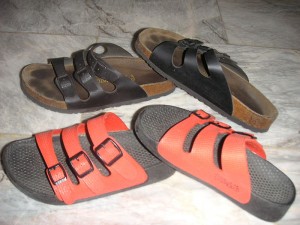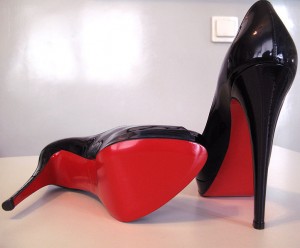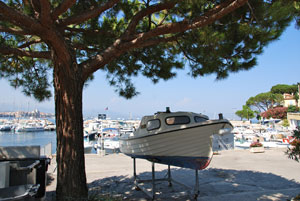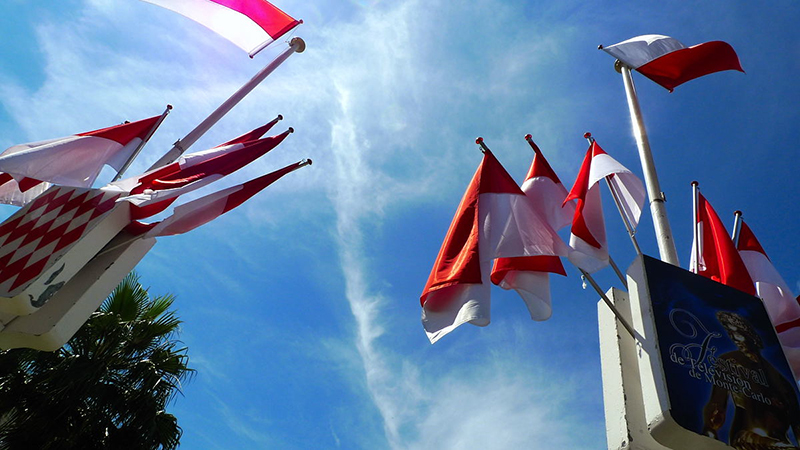The man standing beside my husband Philippe at today’s vernissage is wearing a turquoise linen suit adorned in fine, white, criss-crossing lines. His hair is dark but greying, swept up in a ponytail with curling ends that poke beneath a Bandolino hat. His shoes are, of course, crimson. Crimson, patent wingtips.
He doesn’t look that out of place. Nearby an angular young man with prominent, round glasses is wearing green jeans – a jolting asparagus sort of green, with a lining of sunflower-yellow that’s exposed at the ankle turn-ups. This guy hardly looks out of place, either.
If the Côte d’Azur is boulangeries and grèves and megayachts, as I’ve discussed in various posts, this place is also fashion. Philippe dubs these two chaps and their kind “the Artistes”.
And certainly, artists are one community that’s well represented here at the Monaco Fête Picasso. Through personal invitation of our friend Jean-Louis, who’s centrally involved in this world, we’re here at the Grimaldi Forum in Monaco to witness the inauguration of the season’s new fashion. I mean exhibition. The Monaco Fête Picasso is a pivotal attraction among a wider theme in the Côte d’Azur this summer: celebrating Picasso on the 40th anniversary of his death.
The Président of the Forum (and, I later learn, Monaco’s recent ambassador to France) makes his opening remarks in an airy, glassed-in entry hall. This is a two-pronged exhibition. On one hand, we have the Nahmad Collection that presents 116 of Picasso’s masterpieces in thematic groupings. On the other, we have a collection of Picasso’s works from the Côte d’Azur.
Yes, this event is all about art, and specifically Picasso’s art, but my eyes wander as the Président speaks. Picasso’s works in the adjoining galleries have yet to be unveiled to us, but the fashion is a ready feast.

I spot a woman wearing Birkenstocks with her summer dress. Okay, so one foot is bandaged, but I covet the choice as I crimp my toes in my high-heeled sandals.
Fashion was a decent consideration for me at this event. Last night I asked advice from Philippe, my fashion expert. He’s the French one. I trend toward functionality rather than haute couture. I suggested my bright linen sundress, a simply cut A-line with bold swathes of colour and design. Easy to wear, I called it my Picasso dress to enhance its suitability for the occasion. Even more importantly, the heeled sandals that went with the dress were reasonably comfortable.
This is Monaco! Philippe said. He started rifling through my clothes, becoming increasingly distraught with each flick of a hangar. My second and third suggestions were even less suitable.
You need Dior! he said. You need Valentino!
I pulled out my only such item, a beautifully crafted navy and white sweater set and a pair of skinny white jeans, both with appropriate amounts of lace and ruffles. I’d bought the outfit one afternoon, years ago, on Philippe’s impulse that we should dip into the designer’s shop.
It will probably do, he said. But you need to go shopping.
Most women would rejoice at that comment. I felt exasperated. Philippe headed into the bathroom and began filing his nails.
You’re going all out, I said.
It’s Monaco! he said. We both glanced down at my fingernails. They looked reasonably good, I thought – unpolished but quite shapely given that I never go to a professional. I can’t stand having junk on my nails.
Philippe reminded me of my trouble booking a manicure for our eight-year-old daughter and her cousin a couple weeks ago. Now, he said, you can see why Antibes’ nail salons were all booked up!
Maybe I shouldn’t go to the vernissage? I suggested. Who knows, maybe Trinny Woodall will be there – What Not To Wear and all that.
No, Philippe insisted. Come.
And so I’m here, in Monaco at the Grimaldi Forum, tottering on ridiculous sandals (which, truthfully, are visibly shorter than some heels in the room). And now I’m more obsessed by what other invitees are wearing to this shindig than to what the good Président is saying about the collection of Picassos awaiting our imminent digestion.
The speech is followed by polite clapping, and the crowd converges toward a doorway at the far end of the hall. I’m busy pointing out the Artistes when our pace is slowed by an older lady ahead of us. She’s wearing a tailored, crêpe de Chine dress in spring green. A silk scarf in a green, blue and white floral motif is draped around her shoulders.
Philippe creates a new group. She’s a member of “the Old Divas,” he says. The dress probably cost a fortune 20 years ago, but you can tell she didn’t buy it yesterday.
And indeed, not that anyone is bothered by this fact, I recognize my fashionable, paternal grandmother in such an outfit. It’s hardly a criticism but, yes, another group is evident among us.
The first room of the Nahmad Collection opens out in front of us. I stop to read the exhibition brochure. This collection, formed by two generations, presents masterpieces created between 1901 and 1972. They’re grouped thematically rather than chronologically so that we can compare the progression of Picasso’s approach toward still-life, figure painting, landscape, his studio and such.
A couple rooms into the Nahmad Collection, my feet are smarting. I look longingly at the Artistes and the Old Divas in their more moderate heels. There’s even a beach bum or two wearing comfy sandals, and one couple looks like they just came in from a spot of gardening. I see a second woman with a taped foot placed gingerly in a flat sandal.
I point out the foot to Philippe. That’s how I should’ve done it! I say. By the next room we’re having a petite pause on the benches at the center. Other attendees block Picasso’s works, so we look at these folks instead.&
There’s another Old Diva wearing a crepe floral blouse that definitely could’ve belonged to my dear grandmother. Another woman wears a red silky jumpsuit with baggy, Arabian trousers and a long slit at the back that exposes a red bra. I find the outfit intriguing. Philippe says it’s awful – but he does point out her beautiful nails. Another woman glides around in a flowing, white-and-neutral sundress dolled up with a pair of killer heels and matching handbag. Breaking the image is a hot pink sack slung carelessly over one shoulder. Its contents are evident by the form that presses against its thin cloth. This woman is carrying around her flip-flops.
And then I spot the most exquisitely dressed person in the entire congregation. She’s in her 40s, her sun-blushed hair clipped loosely, artfully, into a twisted chignon. She wears a simple, sleeveless pencil dress (beautifully, it should be said), pure ivory in colour except for a broad band of black at the jewel neckline, which continues as a vertical ribbon down her spine. Her simple, moderately heeled pumps and oversized bag are a neutral taupe. I point her out to Philippe.

The shoes are Louboutin, he tells me. They have the hallmark red adorning their undersides, a stroke of genius from the man behind the brand. He saw a woman painting her nails in that very red, as the story goes, so he used her nailpolish to paint the undersides of her shoes. The woman loved the look so much that the Louboutin shoe designer eventually tried to patent the idea in the US, but other shoemakers ganged up against him in court.
How does Philippe know this stuff? I wonder. In any case, this woman with the Louboutins is hardly an Artiste nor an Old Diva. He calls her a “Femme Fatale”.
Philippe runs into the friend we’re meeting for lunch. As they chat amid Picasso’s canvases depicting his studio life, I move onward, subject-by-subject, until I find myself at a crossroads: the exit from the Nahmed Collection and the entrance to the second part of this exhibition: Picasso’s Côte d’Azur. The front-facing, charcoal wall in the first room declares ”Juan-les-Pins.” That’s the more flamboyant half of Antibes. Basically, it’s our hometown.
Of course! This part of the exhibition is as much about Picasso’s art as the area’s history. I’m propelled immediately inside.
A few years ago I began researching the history of Bellevue, our home in Antibes, scouring local books and research papers, museums and personal memories and postcards. And as it sometimes happens when you start into a new hobby, this new endeavour – recreating former lives in this corner of the world – has become a growing source of intrigue for me. Central to this broad lattice of research is Edouard Muterse, a notable local man who breathed life into our home.
Ahead, in a maze unfolding before me, is an exhibit about how Picasso himself was entwined in this area’s history. And Edouard, I realize, was Picasso’s contemporary – a mere two years older than the renowned painter!
I never knew Picasso found himself in our area as early as 1920, soon after World War I. For three months that summer, Picasso, aged 38, and his wife Olga rented a hillside villa in Juan-les-Pins: Les Sables along the chemin des Sables.
Chemin des Sables! That was Edouard’s street! Sure, his legal career was based in Aix-en-Provence at this point, but he spent decent amounts of time at his family’s home on chemin des Sables – and surely he would’ve stayed during the slow, summer months. Picasso, I now learn, would head out into Juan-les-Pins and Antibes. He’d go to the beaches.
Could the two men, Pablo and Edouard, have taken their morning coffees at the same café? Could they have swum in the same waters? Could they have run into each other amid Juan-les-Pins abundant nightlife?

I head into another room of the exhibit. It’s now 1930 and the Picassos are again in Juan-les-Pins, renting Villa Bachlyk just a block from the beach. He’s working on sand- reliefs, filling his canvases with gathered objects such as driftwood, pieces of rope and, of course, sand.
It was around this time that Edouard, now living full-time back on chemin des Sables, purchased his Hudson Terraplane, one of the first, commercial American cars in the area. He enjoyed driving the ample, seaside roads with his friends and family.
Could Edouard have cruised by Pablo as the artist gathered his driftwood and sand? Could the motor of Edouard’s Terraplane have disrupted the grand master’s contemplation – ever so briefly – as he sat before a sand-relief in his rented villa?
I’m Alice falling down the rabbit hole.
Summer of 1939. Picasso and Dora Maar stay at 44, boulevard Albert 1er in Antibes. At the bottom of that road is the bay where Edouard sailed his boat – the very bay that ripples beneath our Bellevue. Could Pablo have witnessed Edouard’s sail flapping in the wind one morning when he strolled a couple blocks to the seaside? Could he have continued along the promenade as far as the Port de la Salis, where Edouard served as its Président? Might Pablo have stopped among this local community there to shoot the breeze? Might he even have gazed up at the home next door, at the generous curves of our Bellevue, and wondered who lived behind her thick façade?

No, I’m not Alice. I’m Jacques, our artist friend who visited Bellevue a few weeks ago. He learned that Philippe and I are friendly with a woman who lived in Bellevue during the early parts of World War II, not long before Picasso worked in the museum across the bay. Jacques wondered if – possibly – our friend could’ve breathed the very air of Pablo Picasso?
My cellphone goes. “Where r U?” says Philippe’s text. “We r waiting 4 u in lobby.”
I completely missed our rendez-vous. I head back to the glassed-in lobby at the entrance of the Grimaldi Forum. The woman in the red jumpsuit with Arabian trousers lingers with friends. The Artiste in the turquoise suit and crimson shoes chats with another man, a glass in his hand. I find Philippe.
Did you see the priest? he asks. The little, short priest walking around?
No.
I wanted to point him out! He was the confesseur to Prince Rainier! The guy Prince Rainier made all his confessions to! He’s been here in Monaco for decades!
Clearly I have missed out.
And I got to meet Nahmed! Philippe continues delightedly. I told him we have two things in common! We’re born in the same year, and we’re both art collectors!
Okay, maybe I did miss out a little bit, but I still prefer my experience down the rabbit hole.
We head out of the building for lunch, and I try to relay my own enthusiasm for the vernissage. It has nothing to do with Picasso’s evolution as an artist, of course, and I’ve certainly forgotten about the fashions.
As we walk along the promenade beside the Mediterranean, my thumb scrapes over the nail of its neighbouring index finger. Somehow during the experience, I managed to break a nail.
And guess what? I don’t care one bit.


Hi, my name is Jack and I work at Artsy.net. While researching Pablo Picasso I found this post. Great post, by the way.
I actually worked on Artsy’s new Pablo Picasso page, and I think it would be a great resource for your readers. The newly designed page includes hi bio, over 320 of his works, exclusive articles about Picasso, as well as his up-to-date exhibitions – it’s a unique Picasso resource.
There are even 168 works for sale via our website (not that anyone can afford a Picasso, but still interesting).
I’d like to suggest adding a link to Artsy’s Picasso page, as I believe it would benefit your readers: https://www.artsy.net/artist/pablo-picasso
Thanks for your comment, Jack. Happy to help out!